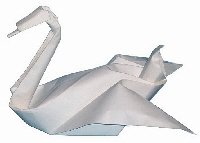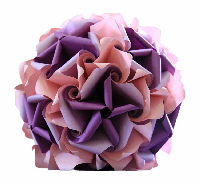|
 Origami (from Japanese for folding paper) is the traditional Japanese art of paper folding. Paper folding probably started in China and Japan before the 10th century AD but Origami is particularly associated with Japan of the 17th century. It was popularised outside Japan in the mid-1900s and has evolved into a modern art form. The goal of origami is to transform a flat sheet of material into a finished sculpture solely through folding and sculpting techniques. Origami (from Japanese for folding paper) is the traditional Japanese art of paper folding. Paper folding probably started in China and Japan before the 10th century AD but Origami is particularly associated with Japan of the 17th century. It was popularised outside Japan in the mid-1900s and has evolved into a modern art form. The goal of origami is to transform a flat sheet of material into a finished sculpture solely through folding and sculpting techniques.
Almost any laminar material can be used for folding; the only requirement is that it should hold a crease. Normal copy paper with weights of about 80 gsm can be used for simple folds, such as a crane or swan. Heavier weight papers of 100 gsm or more can be wet-folded. This technique allows a more rounded sculpting of the model, which then becomes rigid when it is dry.
Origami paper is sold in pre-cut squares of various sizes and may be coloured on one side and white on the other. Origami paper weighs slightly less than copy paper, making it suitable for a wider range of models.
Artisan papers such as lokta and unryu have longer fibres and are often extremely strong. These papers are very thin and compressible, allowing for thin, narrow limbs as in models of insects and other advanced origami designs.
More about origami and paper folding
The number of basic origami folds is small, but they can be combined in a variety of ways to make intricate designs. The designs usually start with a square sheet of paper whose sides may be different colours or prints. Traditional Japanese origami has often been less strict about these conventions, sometimes cutting the paper or using non-square shapes to start with.
In the early 1900s, Akira Yoshizawa and others began creating original origami works. Akira Yoshizawa was responsible for a number of innovations, such as wet-folding and his work inspired a renaissance of the art form. During the 1980s a number of folders started systematically studying the mathematical properties of folded forms, which led to a steady increase in the complexity of origami models, which continued well into the 1990s, after which some designers started returning to simpler forms.
It is common to fold on a flat surface but some origamists or folders like doing it in the air with no tools, especially when they are displaying folding. Many folders believe no tool should be used when folding. However, some tools can help with the more complex models. A bone folder allows sharp creases to be made in the paper easily, whilst paper clips can act as extra pairs of fingers, and tweezers can be used to make small folds. When making complex models from origami crease patterns, it may help to use a ruler and ballpoint embosser to score the creases. Completed models can be sprayed so they keep their shape better, and a spray is needed when wet folding.
 Modular origami consists of putting a number of similar pieces together to form a complete model. Normally the individual pieces are simple but the final assembly may be tricky. Many of the modular origami models are decorative balls like kusudama, the technique differs though in that kusudama allows the pieces to be put together using thread or glue. Modular origami consists of putting a number of similar pieces together to form a complete model. Normally the individual pieces are simple but the final assembly may be tricky. Many of the modular origami models are decorative balls like kusudama, the technique differs though in that kusudama allows the pieces to be put together using thread or glue.
Chinese paper folding includes a style called 3D origami where large numbers of pieces are put together to make elaborate models. Sometimes paper money is used for the modules. This style originated from some Chinese refugees while they were detained in America and is also called Golden Venture folding from the ship that they arrived on.
You can use our handmade natural or vibrant computer papers for most origami designs and lokta artists paper for wet folded origami, as well as our special lokta origami paper that is pre-cut to 20 cm square.
Top of page
|